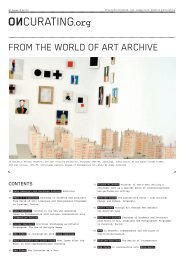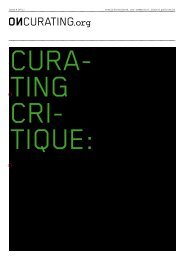Create successful ePaper yourself
Turn your PDF publications into a flip-book with our unique Google optimized e-Paper software.
09 Issue # 11/11 : PublIc Issues<br />
Who won, who lost?<br />
Comparing the old plans and the current product<br />
So what h<strong>as</strong> been gained compared to the old HB Südwest /<br />
Eurogate plans? Is this project better or worse than<br />
the original one? What w<strong>as</strong> improved, who won, who lost?<br />
How have the extended planning process and prolonged<br />
resistance affected the project?<br />
The central aim of extending Zurich's limited central<br />
business district into the station area and of better<br />
using the railway lands h<strong>as</strong> definitely been achieved,<br />
albeit with a different approach. As a consequence of the<br />
decision to build the new underground terminal and the<br />
Post Office's decision to give up its distribution centre,<br />
large parts of the trackfield became available for a<br />
development without expensive decking structures. In ad-<br />
dition, extra railway plots were added in the northwestern<br />
part of the plot to further enlarge the project area.<br />
By leaving the area over the main tracks untouched, much<br />
resistance and many problems were side-tracked. Still,<br />
the amount of total floor space and the mix of uses have<br />
remained within the same range. Of course, the land which<br />
would have been won by the decking is now not available.<br />
However, it must be repeated, it would have been expensive<br />
to create that land; the fact that its development could<br />
not be ph<strong>as</strong>ed w<strong>as</strong> one of the main economic re<strong>as</strong>ons to stop<br />
the project.<br />
The significant difference from an urban design perspective<br />
comes with abandoning the decking of the tracks.<br />
As a major gain, railway access to Zurich and the station<br />
platforms enjoy daylight exposure. The physical appearance<br />
and the perception of the station – including the trackfield<br />
– in the city have <strong>as</strong> such been preserved. What h<strong>as</strong><br />
been lost is the broad deck connection across the tracks<br />
between the two neighourhoods, districts 4 and 5, a fea-<br />
ture many would have welcomed.<br />
Where<strong>as</strong> the physical project h<strong>as</strong> changed and its substance<br />
h<strong>as</strong> been adapted, the effects have by and large remained<br />
the same. Still, looking at the final outcome of the mixed<br />
use development under construction some of the results<br />
can be seen <strong>as</strong> a compromise after struggle l<strong>as</strong>ting fifty<br />
years. More public space and semi-public ground floor uses,<br />
perhaps even the teacher training college in this location,<br />
can be listed on the positive side of the balance sheet.<br />
Some expensive apartments, senior citizen accommodation, a<br />
hotel, and much office space in a central location can be<br />
seen <strong>as</strong> positive or negative, depending on the standpoint.<br />
From the opponents' point of view, the struggle for a more<br />
modest, eco-friendly, neighbourhood-protecting development<br />
h<strong>as</strong> largely been lost. Europaallee does not have much to<br />
offer to the existing social environment. Its enrichening<br />
contribution will be marginal, limited to some new shops,<br />
slightly more public space, but all not corresponding much<br />
with the needs and desires of the area's current inhabitants.<br />
Europaallee is a stepping stone for the further<br />
expansion of the central business district into traditional<br />
working cl<strong>as</strong>s are<strong>as</strong>. Whether and how much the adjacent<br />
neighbourhood will be gentrified and to what extent this<br />
is an effect of Europaallee will probably remain disputed.<br />
Where does this development take Zurich <strong>as</strong> a whole?<br />
The history of HB Südwest and its result <strong>as</strong> Stadtraum HB<br />
have taught the City of Zurich, its planners, politicians,<br />
developers, and corporate elite a number of important<br />
lessons. First, Stadtraum HB h<strong>as</strong> proven that it is still<br />
possible to realize large scale projects in Zurich. After<br />
a number of failed or still contested projects (Zurich's<br />
Convention Centre, Kleeblatt<br />
highrise apartments, Hardturm<br />
football stadium), this<br />
is politically important.<br />
With Stadtraum HB Zurich h<strong>as</strong><br />
also created a new gateway<br />
for those entering the city<br />
by rail. Looking from the<br />
opposite direction, the tra-<br />
ditional central business<br />
district of Bahnhofstr<strong>as</strong>se<br />
h<strong>as</strong> been extended and<br />
strengtened.<br />
Second, Stadtraum HB / Europa-<br />
allee h<strong>as</strong> also shown that an<br />
appropriate planning process<br />
is crucial for this type<br />
of (mega-)project. In stark<br />
contr<strong>as</strong>t to its predecessors<br />
depending on a costly deck<br />
across the tracks <strong>as</strong> a lump<br />
pre-investment, Europaallee<br />
h<strong>as</strong> allowed for a piecemeal<br />
approach in pace with eco-<br />
nomic up- and downturns.<br />
Giving up the decking and<br />
realigning the project's<br />
parameters w<strong>as</strong> also instrumental<br />
in breaching the<br />
oppositional lines.<br />
Thirdly, Europaallee and its<br />
pre-history have clearly<br />
shown the limits of private<br />
public partnerships, which<br />
in the Zurich c<strong>as</strong>e are label-<br />
led <strong>as</strong> a 'cooperative plan-<br />
ning process'. Politically,<br />
the attempts to sideline<br />
democracy with the muchlauded<br />
but undemocratic co-<br />
operative planning process<br />
have failed. From a planning<br />
perspective, the limits to<br />
outline development plans<br />
have become obvious. Public<br />
participation remains the<br />
key factor to successful<br />
planning. The political and<br />
legal struggles have made it<br />
clear that without a very<br />
broad consensus, projects of<br />
this size and scope cannot<br />
be realized within a useful<br />
time frame. Planning expe-<br />
rience from brownfield deve-<br />
lopments in Zürich Nord and<br />
Zürich West, gathered while<br />
HB Südwest tumbled from one<br />
crisis into the next, helped<br />
develop more intelligent co-<br />
operation processes. Europa-<br />
allee is thus also a new<br />
approach to urban development.<br />
The specific style of<br />
planning and development<br />
represents a more sensitive<br />
and inclusionary approach<br />
to urban development. Taking<br />
into consideration many


![Download as PDF [10.6 MB]](https://img.yumpu.com/4266533/9/500x640/download-as-pdf-106-mb.jpg)

